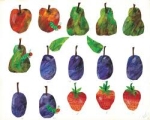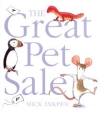This week’s blog is from one of our Coventry teachers, Jan Pringle, who has been putting books to good use in maths lessons.
As a maths leader, I quite often have the privilege of doing planning trawls and looking at weekly and medium term planning from other teachers. I’m often very impressed by the thought and detail that goes into these. But there’s one section that seems very rarely to be given much thought. If your weekly or medium term planning format is anything like mine, there’s a small section headed ‘cross-curricular links’, and I hardly ever see it filled in, except perhaps with the suggestions given on the format itself, and these are nearly always Science based.
On the whole, we are very good these days at making cross-curricular links, particularly at bringing writing opportunities into a whole range of curriculum areas. At the start of units, topic webs are drawn up and connections made – but maths is often very difficult to fit in to these and so we agree that it’s probably best to teach this discretely. I’d be the first to admit that it is often difficult to bring maths into our topic themes – although I do think it’s worth making the effort. It’s so important that children see the relevance of maths to their lives and the way that the skills they learn can be applied. However, one great way of linking maths to other curricular areas is by using story and picture books.
 As I write, my daughter – in her first year of teaching – is spending a few days with us. Yesterday, she was starting to plan the maths for her Year 1 class for the Summer term and looking for activities in particular for time and money. She’d already planned to use Eric Carle’s ‘The Very Hungry Caterpillar’ as a starting point for learning and ordering the days of the week, and ‘What’s
As I write, my daughter – in her first year of teaching – is spending a few days with us. Yesterday, she was starting to plan the maths for her Year 1 class for the Summer term and looking for activities in particular for time and money. She’d already planned to use Eric Carle’s ‘The Very Hungry Caterpillar’ as a starting point for learning and ordering the days of the week, and ‘What’s  the Time, Mr Wolf’ by Colin Hawkins and ‘The Bad-Tempered Ladybird’ (another book by Eric Carle) for telling the time and sequencing the day. I was able to introduce her to the wonderful Mick Inkpen book ‘The Great Pet Sale’ and she then happily spent most of
the Time, Mr Wolf’ by Colin Hawkins and ‘The Bad-Tempered Ladybird’ (another book by Eric Carle) for telling the time and sequencing the day. I was able to introduce her to the wonderful Mick Inkpen book ‘The Great Pet Sale’ and she then happily spent most of the rest of the afternoon having lots of fantastic ideas about how she could use this – her role play area for the start of term will be a pet shop with lots of opportunities for the children to practise paying for items, finding the correct money and giving change, but also stimulating lots of writing opportunities too – descriptions of their pets, instructions for looking after a pet, recounts of visits to a pet shop – like most teachers, given an engaging starting point, the possibilities she’ll find will be almost endless. She also found some fantastic resources to use on T.E.S. and some good labels for her pet shop on Twinkl as well as a reading of the book on Youtube.
the rest of the afternoon having lots of fantastic ideas about how she could use this – her role play area for the start of term will be a pet shop with lots of opportunities for the children to practise paying for items, finding the correct money and giving change, but also stimulating lots of writing opportunities too – descriptions of their pets, instructions for looking after a pet, recounts of visits to a pet shop – like most teachers, given an engaging starting point, the possibilities she’ll find will be almost endless. She also found some fantastic resources to use on T.E.S. and some good labels for her pet shop on Twinkl as well as a reading of the book on Youtube.
I suspect KS1 teachers have always been quite good at using story and picture books in some of their maths work, but as a KS2 teacher I wasn’t so aware of good books with mathematical links until I was introduced to some by the Coventry Primary Maths team at subject leader training and also during my MaST training.
 A particular favourite is Anna Milbourne’s ‘How Big is a Million’ which tells the story of a young penguin eager to find out just what a million looks like. Big numbers tend to fascinate children of all ages and although younger children would love this book with its very simple story line, I’ve also used it very successfully with children in Upper KS2. Another is ‘The Rabbit Problem’ by Emily Gravett, again a very simple story
A particular favourite is Anna Milbourne’s ‘How Big is a Million’ which tells the story of a young penguin eager to find out just what a million looks like. Big numbers tend to fascinate children of all ages and although younger children would love this book with its very simple story line, I’ve also used it very successfully with children in Upper KS2. Another is ‘The Rabbit Problem’ by Emily Gravett, again a very simple story attractively presented, but with some quite challenging maths to explore for older primary children. I’ve used this with Upper KS2 when we’ve been looking at number sequences to lead into looking at the Fibonacci sequence and algebra.
attractively presented, but with some quite challenging maths to explore for older primary children. I’ve used this with Upper KS2 when we’ve been looking at number sequences to lead into looking at the Fibonacci sequence and algebra.
 There are so many books that can be successfully used in maths, from simple counting books like the beautiful Anthony Browne book ‘One Gorilla’, through books about measures like Pamela Allen’s ‘Mr Archimedes’ Bath’,
There are so many books that can be successfully used in maths, from simple counting books like the beautiful Anthony Browne book ‘One Gorilla’, through books about measures like Pamela Allen’s ‘Mr Archimedes’ Bath’, 
to books about working with very large numbers like ‘Anno’s Mysterious Multiplying Jar’ by  Anno Masaichiro. For fans of the ‘Horrible History’ books, there is even a whole series of ‘Murderous Maths’ books written by Kjartan Poskitt.
Anno Masaichiro. For fans of the ‘Horrible History’ books, there is even a whole series of ‘Murderous Maths’ books written by Kjartan Poskitt.
I’m continually collecting new ideas for my Pinterest board and Coventry Primary English also have their own board of ideas.
We’d like to thank Jan for a fabulous blogpost. If you have more marvellous maths ideas, do share them with us!









